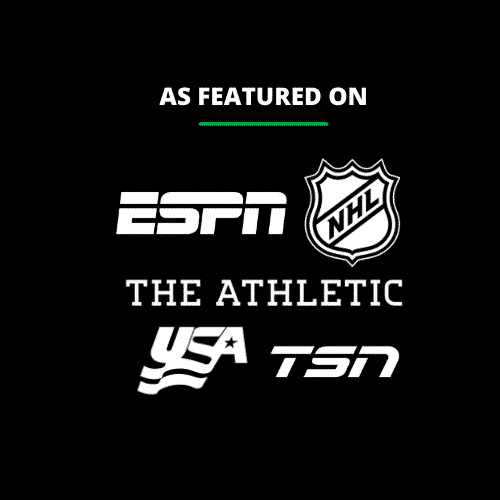What is junior hockey?
Junior hockey is generally considered “amateur” hockey, as the players are not considered professional. In some cases, however, Junior hockey leagues (Major Junior hockey specifically, the CHL in Canada) are not viewed as amateur leagues. Understanding levels of junior hockey leagues is confusing and in this guide, we’re going to unpack every level of junior play. Junior Hockey is very different than it’s youth hockey counterpart, for more on the levels of youth hockey check out our guide to youth hockey levels.
With dozens of different Junior Hockey Leagues throughout North America and hundreds of Junior Hockey teams, understanding it all can be a bit of a challenge to those not familiar with the system. In this article, we’re going to do our best effort to clearly explain the levels of junior hockey, as well as the various junior hockey leagues throughout the USA and Canada.
Since writing this, I’ve still been getting the question of, what is the best junior hockey league in North America?
Ranked in order of which leagues send the most prospects to the NCAA Division 1 level, it would be the USHL. However, the two top junior leagues in Canada, the BCHL and AJHL, as well as the United States only sanctioned Tier 2 league the NAHL, are right behind it.
Junior Hockey leagues are feeder leagues designed to develop players for success at the next level. Not every league is perfect and some are much better than others. If your player or goalie has a shot at playing elite level Junior Hockey, take it.
If your son or daughter has been approached by a junior hockey team, the number one thing you can do to determine the leagues legitimacy is looking up advancement. Never heard of the league? That’s fine. For those unfamiliar, you may not have heard of a league like the SIJHL (Canadian Junior A, good league). Leagues that consistently send it’s ex-players to the CHL / NCAA / CIS / ECHL ranks and beyond are generally pretty quality leagues. As a rule of thumb, the advancement of players to leagues “above” their level of play is always a good thing.
Which Junior Hockey Leagues send the most players to Division 1 NCAA?
- USHL – United States Hockey League (Tier 1)
- NAHL – North American Hockey League (Tier 2)
- BCHL – British Columbia Hockey League (Canadien Junior A, Tier 1)
- AJHL – Alberta Junior Hockey League (Canadien Junior A, Tier 1)
Those are the 4 top Junior Leagues in North America, without question. When it comes to scouting goalies, or scouting hockey players in general, players who can separate themselves in these leagues have the best opportunity to move up to the next level. Statistically speaking, players playing in their age out year in one of these four leagues are more likely to go on to play NCAA than the CHL, as eligibility in the CHL has also run out.
Before we jump into this article, let’s take a look at leagues throughout the USA and Canada that are considered to be “Junior hockey”.
In Canada, Junior Hockey is considered to be one level above minor hockey. In the United States, Junior Hockey is above “Youth Hockey” (the equivalent of Minor Hockey in Canada) as well as High School or AAA hockey.
Junior Hockey Explained
As you’re reading this, keep in mind, there are many different levels of Junior Hockey in North America. If you’re being recruited to play in a Junior Hockey League, doing a little research is always a wise idea. Below, we’ve embedded a video from our friend Cooper Lukenda, talking about his experience playing Junior Hockey.
Cooper is an excellent resource for goalies, with a growing Youtube Channel. You can check out Cooper Lukenda on Youtube, here.
Junior Hockey Leagues in North America
The list below is a list of the top junior hockey leagues in North America. Note, the NCAA will allow players who have played in any league but the CHL to compete in the NCAA. The reason CHL players cannot play in the NCAA is because they’re given a stipend, thus forfeiting their NCAA eligibility. In Canada, players who have played in the CHL are still eligible to play University hockey, also known as “U Sports”. The list below is not broken down by “which league is best”, it is simply a list of the league.
Canadien Junior A hockey (which consists of 10 leagues) is comparable to the USHL and NAHL, though many would argue most USHL teams produce more NCAA D1 players than any CJHL team. To be fair, the top leagues in Canadien Junior A, those most comparable to the USHL / NAHL, are the BCHL and AJHL.
- CHL – Canadien Hockey League
- WHL – Western Hockey League
- OHL – Ontario Hockey League
- QMJHL – Quebec Major Junior Hockey League
- CJHL – Canadien Junior Hockey League (Junior “A”)
- AJHL – Alberta Junior Hockey League
- SJHL – Saskatchewan Junior Hockey League
- MJHL – Manitoba Junior Hockey League
- SIJHL – Superior International Junior Hockey League
- NOJHL – Northern Ontario Junior Hockey League
- OJHL – Ontario Junior Hockey League
- CCHL – Central Canada Hockey League
- QJAAAHL – Quebec Junior AAA Hockey League
- MHL – Maritime Hockey League
- USHL – United States Hockey League (Tier 1)
- BCHL – British Columbia Hockey League (formerly a part of the CJHL)
- NAHL – North American Hockey League (Tier 2)
- NA3HL – North American “Tier 3” Hockey League (Tier 3)
- EHL – Eastern Hockey League “Tier 3”
- USPHL NCDC – United States Premier Hockey League “National Collegiate Development Conference” (Not Sanctioned)
- Other Junior Hockey Leagues – Canada Junior B / C, WSHL, and Others
- Canada Junior B, C, D
What are the levels of Junior Hockey?
An easy way to remember which level of Junior Hockey a league is in, is to break them down in this order.
- Major Junior – the “CHL” contains three leagues, the Western Hockey League, the Ontario Hockey League, and the Quebec Major Junior Hockey League
- Tier 1 – technically, Canadien Junior “A” leagues fall into this category, also, the USHL is Tier 1
- Tier 2 – though there are some leagues within the CJHL, Canadien Junior A, that would be considered Tier 2 level, the main league in Tier 2 is the NAHL or Canadien Junior “B”.
- Tier 3 – leagues like the NA3HL
Because there are many different junior leagues, it’s not easy to rank leagues against each other, especially when both the United States and Canada have different leagues. For example, in Canada, the CHL is known as the top “junior” league, even though the NCAA does not recognize CHL players as eligible for NCAA participation. The United States has a clear winner for it’s top junior league, the USHL, as it’s the only Tier 1 USA Hockey sanctioned junior league in the country.
Let’s make “how to understand junior hockey leagues” simple.
The first thing to remember in trying to understand Junior Hockey is that there are two different governing bodies in North America. In the states, USA Hockey sanctions it’s leagues. In Canada, Hockey Canada does the same.
Typically, the best junior hockey leagues are those that fall under USA Hockey or Hockey Canada. This isn’t to say that a league not sanctioned by either is a bad league (see, Adam Vay, Minnesota Wild Prospect of the WSHL), but as a rule of thumb the baseline for how “good” a league is, is based off of it’s sanctioned counterpart. USA Hockey and Hockey Canada sanction the best leagues on the higher end.
That does not always mean that just because a junior hockey league is sanctioned by USA Hockey or Hockey Canada, that it’s the best league. The North American Tier 3 league is, skill wise, on the lower end as far as Junior leagues are concerned and it is sanctioned by USA Hockey.
Canada vs. USA Junior Hockey Leagues
Hockey Canada structures it’s Junior Hockey in a slightly different fashion than USA Hockey. HC runs several different tiers of Junior Hockey, including “Major Junior”. USA Hockey, on the other hand, runs three tiers of its Junior Hockey system. Tier’s 1-3.
Canadian Major Junior & Junior Hockey Leagues
In Canada, we have the Canadian Hockey League (the CHL) and the Canadian Junior Hockey League (the CJHL). As far as the NCAA is concerned here in the states, players who play in the CHL do not retain their amateur status. So, to compare apples to apples, the top leagues in the CJHL is often times thought of as comparable to the USHL / NAHL.
The CHL is labeled as “Major Junior” hockey and the CJHL is “Junior Hockey”.
What is Major Junior Hockey?
The CHL, or Canadien Hockey League, made up of 3 individual leagues in Canada, is known as “Major Junior” Hockey. It’s called “Major” Junior as it is a level above Canadien Junior A.
CHL – Canadien Hockey League
- Western Hockey League
- Ontario Hockey League
- Quebec Major Junior Hockey League
The Canadien Hockey League (CHL) has consistently been one of the top development leagues for the National Hockey League, though in recent years it has been rivaled by the NCAA. There are generally two routes to professional hockey in North America. The first is through Major Junior, the second through the NCAA.
Teams in the CHL play for their respective league trophies, with the winner of each league moving on to play for the Memorial Cup (one team from each league in the CHL plus a host city plays for the Memorial Cup).
The CHL produces more NHL talent than it’s CJHL counterpart, but this does not mean that developmentally, it’s a better league. Playing in the CHL means you’ll forgo your NCAA eligibility, which can hurt development further down the road. Unlike junior hockey in the United States, the CHL consistently pulls top talent that would otherwise end up in the Canadian Junior Hockey League, which waters down some of the CJHL’s leagues.
Is the CHL or the CJHL better?
The CHL produces more NHL players than the CJHL does, however, there is a huge distinction between these two governing bodies. The CHL has just 3 leagues, where as the CJHL has 9.
WHL – The Western Hockey League
Comprised of 22 teams currently, the WHL was actually considered an “outlaw” league at first. The WHL, as you can imagine, holds most of it’s teams in Western Canada and the Northwest United States. Teams in the WHL play for the Ed Chynoweth Cup, with the winner moving to the Memorial Cup playoffs.
The WHL, or Western Hockey League, is a Major Junior Hockey League under the governing body of the CHL. The CHL includes the OHL, which we’ll outline next as well as the QMJHL.
OHL – The Ontario Hockey League
Currently at 20 teams, the OHL could very well be the highest profile league in the CHL due to its geographical positioning in comparison to the WHL and QMJHL. Aside from comparing the number of NHL players this league has produced and the number of Memorial Cup victories for the OHL, there is no great comparison of it’s level of play to other CHL leagues. Any program that competes in the CHL in Canada is an elite program capable of sending players to the NHL and professional ranks. This league has several teams in Michigan and one in Pennsylvania.
The OHL, or Ontario Hockey League, is famous for producing Connor McDavid. While McDavid is the best hockey player to ever play in the OHL, there are a laundry list of household names who cut their teeth in the OHL.
QMJHL – The Quebec Major Junior Hockey League
The QMJHL is currently the only CHL league that does not have a team located in the United States. The league spans eastern Canada and has an impressive list of players in the NHL (see, Corey Crawford) as well as retirees Patrick Roy, Mike Bossy, and Mario Lemieux.
The QMJHL’s most well known player is Sidney Crosby, who played 2 years and racked up an impressive 2.5 points per game playing for Rimouski Océanic.
Here’s some Major Junior FAQs.
What is the AHL under 20 rule?
The AHL under 20 rule was created for CHL teams to attract top talent back. What it means is, if a player is under 20 does not make the NHL club, they must be sent back to the CHL team they’re currently with.
Can players under 20 play in the AHL?
Yes, they can. In fact, you only have to be 18 to play in the AHL. A longstanding agreement between the CHL and the AHL actually requires teams to send prospects who do not make the NHL club back to their CHL team, if they’re with one. So the “AHL Under 20” rule is actually only the “AHL Under 20 if you’re on a CHL team”, rule.
What is the age limit for Major Junior Hockey?
Players can play until they are 20 years old. As long as they do not turn 21 prior to the start of the season, you’re still eligible for the CHL, or Major Junior.
BCHL – The British Columbia Hockey League (Independent)
After the 2021 season, the BCHL opted not to renew it’s contract with the CJHL. The BCHL is a standalone league, no longer a part of the CJHL. The BCHL only became better after this decision, as it expanded it’s ability to recruit players from outside it’s provincial territory.
If the BCHL were a part of the CJHL to this date, it would be the best league in Canada’s Junior A system.
The BCHL, or British Columbia Hockey League is currently composed of 17 teams located in the Canadian province of British Columbia. Of any of the CJHL leagues, the BCHL is arguably the most well known as it has produced more NCAA hockey players than any of the other leagues in the Canadian Junior Hockey League.
The BCHL’s most famous alumni is Milan Lucic, who played for the Coquitlam Express prior to his legendary career with the Boston Bruins. Other notable alumni of the BCHL include Jamie Benn and goalie Laurent Brossoit.
CJHL – Canadien Junior Hockey League (Junior “A”)
For Canadian hockey players interested in further continuing their career in the NCAA, the CJHL is an excellent option. While the quality of play in the CHL (Major Junior) may be better than a large chunk of leagues in the CJHL, players who play Major Junior will forgo any NCAA eligibility in the United States.
It’s worth noting, in Canada, you can play Major Junior hockey and still play college hockey afterwards, it’ll just have to be in the Canadian system which is known as USports.
The CJHL is considered to be Junior A Hockey, or Tier 1 Hockey. The reality is that when compared to Tier 1 in the United States, the USHL sends far more players to Division 1 than the CJHL as a whole does. While it may not be totally fair, there are simply less Tier 1 junior options in the United States and the US loses less of it’s players to Major Junior as compared to Canada.
Recent CJHL Championship Winners
Just like the Memorial Cup of the Canadian Hockey League, the CJHL holds it’s own championship with winners of each of it’s leagues. The CJHL Championship is currently known as the Centennial Cup, having switched over from the RBC Cup after the 2017-18 season.
- 2022-23: Brooks Bandits (AJHL)
- 2021-22: Brooks Bandits (AJHL)
- 2020-21: no championship held
- 2019-20: no championship held
- 2018-19: Brooks Bandits (AJHL)
- 2017-18: Chilliwack Chiefs (BCHL)
- 2016-17: Cobourg Cougars (OJHL)
- 2015-16: West Kelowna Warriors (BCHL)
- 2014-15: Portage Terriers (MJHL)
- 2013-14: Yorkton Terriers (SJHL)
- 2012-13: Brooks Bandits (AJHL)
- 2011-12: Penticton Vees (BCHL)
- 2010-11: Pembroke Lumber Kings (CCHL)
- 2009-10: Vernon Vipers (BCHL)
- 2008-09: Vernon Vipers (BCHL)
What is the age limit for the CJHL or Canadien Junior A?
20 years old. Actually, for most Junior Leagues, 20 is the cut off.
People often ask whether or not the CHL is better than the CJHL. The answer to that is not as straightforward as you might assume. On paper, the CHL produces more immediate, NHL ready talent. But that’s because in the CHL, you do not have an amatuer status. Once you complete your eligibility in the league, you must go on to play Professional hockey, or play U Sports in Canada (Canada’s version of the NCAA in the US).
Players who play Major Junior hockey in Canada are currently not eligible to play NCAA hockey in the United States. While they cannot play in the NCAA, CHL players who do not sign a professional contract can play in Canada’s version of the NCAA (U Sports / CIS).
Players that play in the CJHL, however, are eligible to play in the NCAA. The NCAA currently revokes eligibility for athletes that have played in the CHL.
Note: there are cases of CHL players playing in the NCAA (albeit rare)
Inside the CJHL, we’ve got several leagues. For the purposes of this article, we’ll focus on Junior A, but know that there is Junior B, etc. As far as development for play at the Collegiate (NCAA) level, the majority of Division 1 hockey players that play Junior Hockey in Canada play in just a few different leagues inside the CJHL.
For the most part, these leagues are ordered by the number of players they send to the Collegiate / Professional Ranks however several in the middle / bottom are up for debate.
AJHL – Alberta Junior Hockey League
The AJHL stands for the Alberta Junior Hockey League, based in Canada’s province of Alberta. Pound for pound, this league is right up there with the BCHL and in recent years, the argument could be made that it’s as good or better as compared to the BCHL.
The Brooks Bandits of the AJHL have dominated the CJHL Championship in recent years, having won it 3 times in a row as of 2022-23. If you look back the last decade, the Brooks Bandits have actually won this tournament 40% of the time.
The AJHL’s most famous alumni is Brayden Point, who played 4 games for the Canmore Eagles prior to the Moose Jaw Warriors of the WHL. Colton Parayko is probably a better example of somebody who had a lot of development in this league, as he played two full seasons with the Fort McMurray Oil Barons prior to playing NCAA Division 1 for Alaska Fairbanks. Notably, Cale Makar also played in the AJHL.
OJHL – Ontario Junior Hockey League
The OJHL, or Ontario Junior Hockey League, has produced some famous hockey players over the years, largely due to the fact that hockey hotbed Toronto is in the heart of the province.
This is an excellent league in the CJHL system, although teams here lose of the top Canadian talent to the Ontario Hockey League. In terms of competitiveness after the BCHL and the AJHL, the other leagues listed below lose a bit of prestige due to the fact that they pull largely local talent to the province as compared to United States talent.
Of course, this is not to say that US hockey players are better than Canada’s, it’s just that the number of US players who opt to play in the OJHL, or any of the other CJHL leagues listed below is lower than the number who will play Junior A hockey in the BCHL or AJHL.
The OJHL has had some pretty famous NHL players come through it’s ranks, including Brent Burns, Owen Tippet, John Tavares, and many others, but these players have not stuck around long. The reason the OJHL doesn’t produce more NHL players is because in Canada, specifically Ontario, these players are heavily recruited to play in the OHL at the Major Junior level.
CCHL – Central Canada Hockey League
SJHL – Saskatchewan Junior Hockey League
MJHL – Manitoba Junior Hockey League
SIJHL – Superior International Junior Hockey League
NOJHL – Northern Ontario Junior Hockey League
QJAAAHL – Quebec Junior AAA Hockey League
MHL – Maritime Hockey League
United States Junior Hockey Leagues
When compared side by side with Canada, it would seem that with just a few junior hockey leagues, the United States and USA Hockey have almost nothing. In fact, that’s far from the case. USA Hockey has three tiers of junior hockey that they govern.
Tier 1: The USHL – United States Hockey League
One of the top development routes to NCAA D1 and beyond, the USHL continues to churn out prospects at a prolific rate. The USHL is currently composed of 16 teams, with it’s oldest team the Waterloo Blackhawks, dating back to 1962.
If you’re being considered for play in the USHL, you are well aware of the fact that you are well qualified to play NCAA Division 1 hockey. It’s worth mentioning that many of these teams float their budgets with summer camps, so simply because you’re going to a USHL camp does not guarantee you any roster spot during teh season.
Tier 2: The NAHL – North American Hockey League
Known as a league for the development of goaltenders in recent year, the NAHL bolsters a solid list of ex-players in the NHL and beyond. Teams continue to feed NCAA D1 programs with talent.
Tier 3: Rocky Mountain Junior Hockey League
What is the difference between Tier 1 and Tier 2 Junior Hockey?
Unlike Canada, The United States uses “Tiers” to discern competition level in it’s Junior Hockey system. USA Hockey sanctions just one Tier 1 league, the USHL and 1 Tier 2 league, the NAHL in the United States. In Canada, there are multiple levels of Junior hockey including Major Junior, Junior A, B, C and even D.
USHL – United States Hockey League (Tier 1)
Aside from Major Junior, which most don’t even consider to be Junior Hockey, the USHL is the best Junior League in North America. This league sends more players to Division 1 schools than any other league.
Can you play in the USHL if you’ve played in the CHL?
Yes. The only restriction for playing elsewhere if you’ve played in the CHL is playing in the NCAA. Per NCAA guidelines, players that play in the CHL lose their eligibility for NCAA hockey.
Can you go from the USHL to the CHL?
Yes, you can. Be aware, that whenever you transition to the CHL, you may forfeit your NCAA eligibility.
Is the USHL or the CHL Better?
This is relatively subjective, depending on who you ask. If you live in Canada, the CHL is likely a better option. If you’re living in Canada and you’re not on the NHL Central Scouting list (which, if you’re 16, you’re likely not), considering further development in the NCAA playing Division 1 may be a worthwhile endeavor.
For residents of the United States, any opportunity to play in the USHL is likely going to make this an easy decision. The only time that it truly makes sense to jump ship and go play in the CHL as a United States resident is when you are pretty confident that you may be a 1st round draft pick.
There is no guarantee of anything, of course, so keeping the door open for further development after your junior career is over is something that should be considered. For a US resident to consider playing in the CHL over the USHL, you should be pretty confident that you are not just a great player, but a generational talent.
NAHL – North American Hockey League (Tier 2)
The North American Hockey league is arguably the second best junior hockey league in North America.
Is the NAHL better than BCHL or AJHL?
Unless you had a situation where these two leagues played each other often, it’s tough to say. In terms of which league sends more players to the NCAA, the NAHL is consistently 2nd in North America behind only the USHL. But, that’s also due to the fact that it’s located in the United States.
NA3HL – North American Tier 3 Hockey League (Tier 3)
Still need more?
The NA3HL, a “feeder league” to the NAHL, is sanctioned by the North American Hockey league as well as USA Hockey, as one of the only Tier 3 Junior Hockey Leagues in North America.
EHL – Eastern Hockey League “Tier 3”
The EHL, also known as the Eastern Hockey League, is a Tier 3 junior league sanctioned by USA Hockey based on the East Coast of the United States.
Other Junior Hockey Leagues – Canada Junior B / C, WSHL, and Others
Getting exhausted yet?
The leagues we’ve covered here are just the ones sanctioned by the two major governing bodies of hockey in North America. There are a plethora of other junior leagues that exist and can offer opportunities for development.
It’s important to remember that hockey is a game we are lucky to play. If you’re playing and having fun doing it, does it matter where you play? Not everything is about success at the next level.
United States Premier Hockey League NCDC
The USPHL made a move to have a “free to play” portion of their league this season, calling it the National Collegiate Development Conference. This was denied by USA Hockey and the USPHL then pulled it’s entire status as being governed by USA Hockey.
The USPHL is an interesting league and the NCDC as well, they continue to send prospects to the College ranks. Especially for athletes on the Eastern side of the United States (NAHL / USHL located largely in Central US), the USPHL is an option.
Canada Junior B, C, D
Competition wise, Junior B hockey in Canada is generally thought of as a step down from Junior A. Many Junior B teams consist of players that will eventually go on to play Junior A. Due to the vast expanse of the country, not every city can support or afford to have a Junior A team. These cities often times host Junior B or Junior C competition.
Everything you need to know about Junior Hockey
How are Junior Hockey Teams ranked?
Every individual Junior Hockey League has it’s own ranking system, many of which follow standard wins and losses and strength of schedule protocol. In cases where multiple leagues make up a greater league, strength of schedule and games versus teams in matching leagues is a major factor in ranking Junior Hockey Teams.
What level is Junior C hockey?
Junior “C” Hockey is a level of Canadien Hockey that is thought of largely as a developmental league for Canadien Junior A and Junior B clubs. Junior C Hockey in Canada is popular in areas where towns are located close together geographically.







